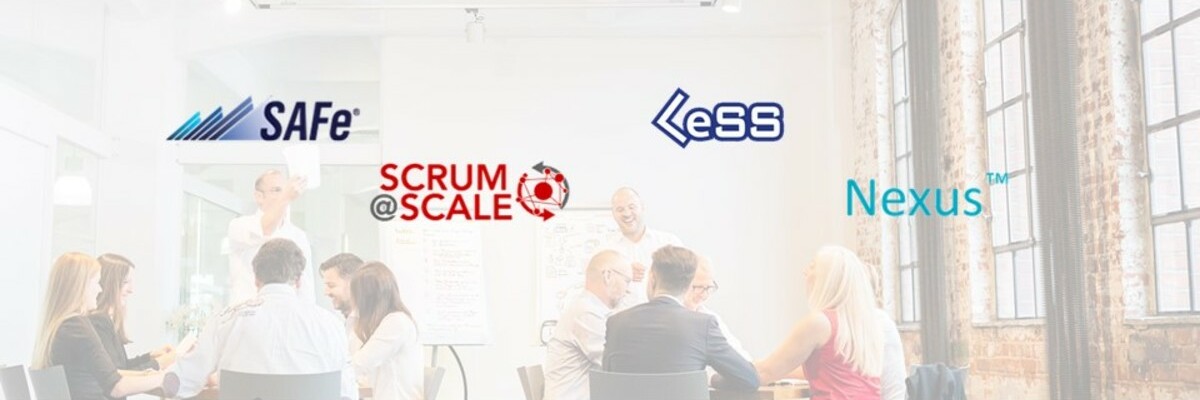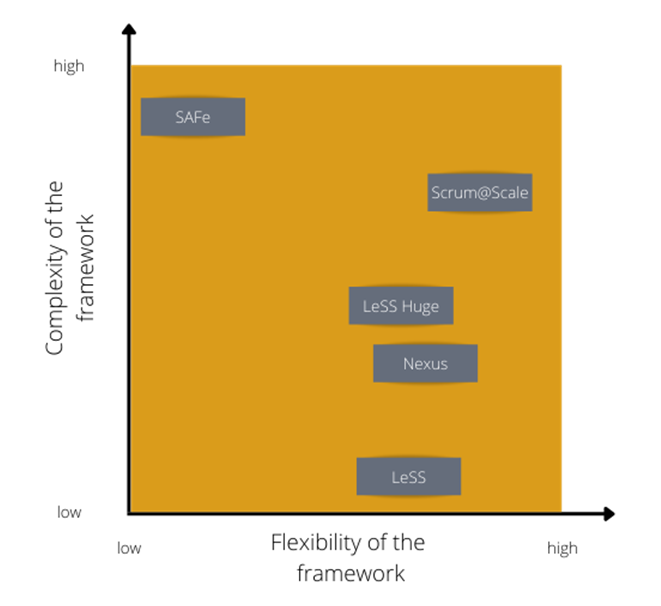Scaling
Two success factors are small, autonomous teams and empirical process control. But with a small team, more extensive complex development projects cannot be realized. So the key question is how we can maintain the benefits of agile at scale. This is where the various agile scaling frameworks come into play.

Reasons for scaling
Most companies first gain experience in dealing with agile principles by using SCRUM or Kanban in manageable pilot projects or selected development areas. That is also correct in such a way. If there are real successes, the companies will promote the agile mindset and further roll out agile leadership and working methods:
- More projects or development groups will use Scrum or Kanban.
- Large-scale and complex projects will be executed in an agile manner
- Entire value streams will become agile
- The entire organization will become agile
Scaling frameworks at a glance
Agile scaling frameworks extend Scrum with new structural elements for contextual scaling. The frameworks that are probably most widely used in the DACH region are SAFe®, LeSS®, Scrum@Scale® and NEXUS®. The higher complexity of the scaling frameworks compared to Scrum places significantly higher demands on leadership behavior, systems thinking at the organizational and product level, continuous integration capability, and the collaboration of distributed teams.
The self-image and complexity of the various agile scaling frameworks differ significantly in some cases. On the other hand, the principle of empirical process control also applies to agile scaling. So it doesn't help to introduce an agile scaling framework dogmatically. It is more important to apply the agile principles consistently, to gather experience and to adapt them. Some frameworks emphasize this self-understanding more than others. This is how learning teams become learning organizations.
Descriptive versus prescriptive
The diversity of the various frameworks allows each company to develop an approach that fits well with its specific starting situation and objectives. In particular, the differences in flexibility and modularity play a major role here.
Flexible frameworks such as Scrum@Scale enable a gradual and cautious introduction. The framework is introduced and experienced step by step depending on the concrete need for action of the company. In doing so, priority is given to starting with the modules that contribute most to achieving the objective.
Prescriptive approaches such as SAFe® give inexperienced companies more confidence because they offer concrete practices and a prepared implementation roadmap. Their systematic and structured nature is more appealing to executives used to complex traditional project management systems and detailed product development processes. However, their complexity is also very high.
You can't do it without change management
Whichever agile scaling framework you choose. Even more than when piloting Scrum or Kanban in small projects, the following applies to scaling:
- Put in place accompanying change management.
- Demonstrate the need for change. Convince your employees.
- Train your managers. Only then can they support their teams as servant leaders.
- Ensure proactive leadership. Leaders must internalize and exemplify agile principles.
- Train your team members. Make sure you have a sufficient number of agile coaches.
- Generate and communicate quick wins.
Your benefit
- Agile scaling frameworks do not contradict the success factors of Scrum.
- The frameworks most widely used in the DACH region are probably SAFe®, LeSS®, Scrum@Scale® and NEXUS®.
- The self-image and complexity of the various agile scaling frameworks differ considerably.
- The higher complexity places significantly higher demands on leadership behavior, systems thinking at the organizational and product level, continuous integration capability, and the collaboration of distributed teams.

